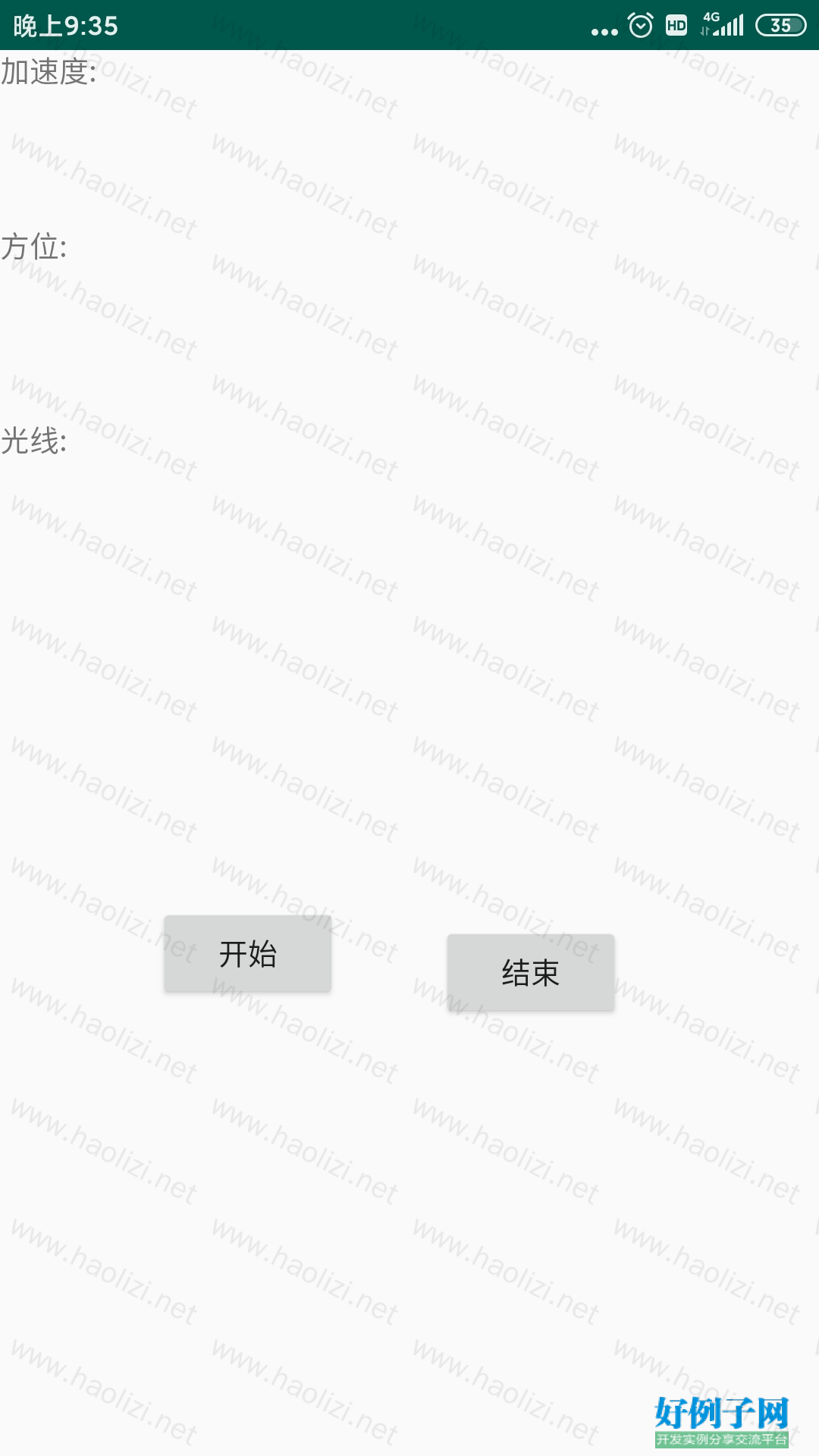实例介绍
【实例截图】

【核心代码】
package com.example.admin.myapplication;
import android.app.Activity;
import android.content.Intent;
import android.hardware.Sensor;
import android.hardware.SensorEvent;
import android.hardware.SensorEventListener;
import android.hardware.SensorManager;
import android.os.Bundle;
import android.view.View;
import android.widget.Button;
import android.widget.TextView;
public class MainActivity extends Activity implements SensorEventListener {
private SensorManager mSensorManager;
private Sensor mAccelerometer;
private Sensor mOrientation;
private Sensor mLight;
private TextView tAccelerometer;
private TextView tOrientation;
private TextView tLight;
private Button mcontinue;
private Button mpause;
int b;
@Override
public void onCreate(Bundle savedInstanceState) {
super.onCreate(savedInstanceState);
setContentView(R.layout.activity_main);
mcontinue = (Button) findViewById(R.id.button1);
mpause = (Button) findViewById(R.id.button2);
mcontinue.setOnClickListener(new View.OnClickListener() {
@Override
public void onClick(View v) {
b=1;
}
});
mpause.setOnClickListener(new View.OnClickListener() {
@Override
public void onClick(View v) {
b=2;
}
});
tAccelerometer = (TextView) this.findViewById(R.id.tAccelerometer);
tOrientation = (TextView) this.findViewById(R.id.tOrientation);
tLight = (TextView) this.findViewById(R.id.tLight);
// 获得传感器管理器
mSensorManager = (SensorManager) getSystemService(SENSOR_SERVICE);
//获得加速度传感器
mAccelerometer = mSensorManager
.getDefaultSensor(Sensor.TYPE_ACCELEROMETER);
//获得方向度传感器
mOrientation = mSensorManager.getDefaultSensor(Sensor.TYPE_MAGNETIC_FIELD);
//获得光线传感器
mLight = mSensorManager.getDefaultSensor(Sensor.TYPE_LIGHT);
}
protected void onResume() {
super.onResume();
//对加速度传感器注册传感器监听器
mSensorManager.registerListener(this, mAccelerometer,
SensorManager.SENSOR_DELAY_NORMAL);
//对方向传感器注册传感器监听器
mSensorManager.registerListener(this, mOrientation,
SensorManager.SENSOR_DELAY_NORMAL);
//对光线传感器注册传感器监听器
mSensorManager.registerListener(this, mLight,
SensorManager.SENSOR_DELAY_NORMAL);
}
protected void onPause() {
super.onPause();
// 取消传感器监听器的注册
mSensorManager.unregisterListener(this);
}
public void onAccuracyChanged(Sensor sensor, int accuracy) {
// 在此方法中,编写当某个传感器的精度发生变化时应执行的操作
}
public void onSensorChanged(SensorEvent event) {
// 在此方法中,编写当某个传感器的数值发生变化时应执行的操作
// 得到方向的值
if (b==1) {
float x = event.values[1];
float y = event.values[2];
float z = event.values[3];
if (event.sensor.getType() == Sensor.TYPE_MAGNETIC_FIELD) {
tOrientation.setText("方位: " x ", " y ", " z);
}
// 得到加速度的值
else if (event.sensor.getType() == Sensor.TYPE_ACCELEROMETER) {
tAccelerometer.setText("加速度: " x ", " y ", " z);
} else if (event.sensor.getType() == Sensor.TYPE_LIGHT) {
tLight.setText("光线: " event.values[0]);
}
}
else if(b==2){
tOrientation.setText("方位: " );
tAccelerometer.setText("加速度: " );
tLight.setText("光线: " );
}
}
}
标签: 传感器
小贴士
感谢您为本站写下的评论,您的评论对其它用户来说具有重要的参考价值,所以请认真填写。
- 类似“顶”、“沙发”之类没有营养的文字,对勤劳贡献的楼主来说是令人沮丧的反馈信息。
- 相信您也不想看到一排文字/表情墙,所以请不要反馈意义不大的重复字符,也请尽量不要纯表情的回复。
- 提问之前请再仔细看一遍楼主的说明,或许是您遗漏了。
- 请勿到处挖坑绊人、招贴广告。既占空间让人厌烦,又没人会搭理,于人于己都无利。
关于好例子网
本站旨在为广大IT学习爱好者提供一个非营利性互相学习交流分享平台。本站所有资源都可以被免费获取学习研究。本站资源来自网友分享,对搜索内容的合法性不具有预见性、识别性、控制性,仅供学习研究,请务必在下载后24小时内给予删除,不得用于其他任何用途,否则后果自负。基于互联网的特殊性,平台无法对用户传输的作品、信息、内容的权属或合法性、安全性、合规性、真实性、科学性、完整权、有效性等进行实质审查;无论平台是否已进行审查,用户均应自行承担因其传输的作品、信息、内容而可能或已经产生的侵权或权属纠纷等法律责任。本站所有资源不代表本站的观点或立场,基于网友分享,根据中国法律《信息网络传播权保护条例》第二十二与二十三条之规定,若资源存在侵权或相关问题请联系本站客服人员,点此联系我们。关于更多版权及免责申明参见 版权及免责申明



网友评论
我要评论